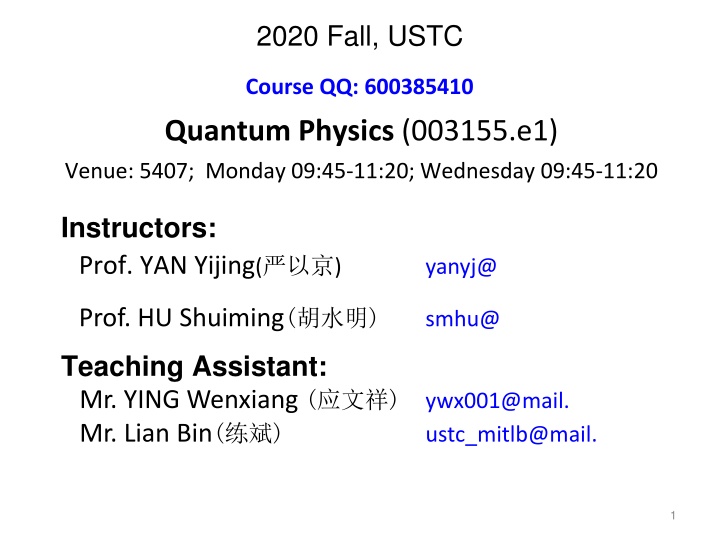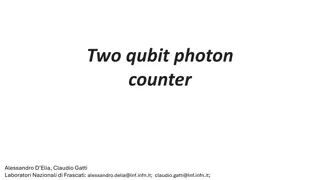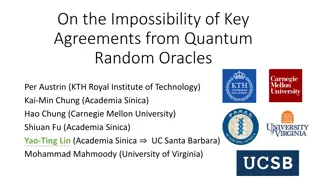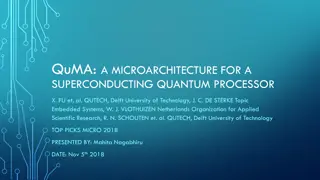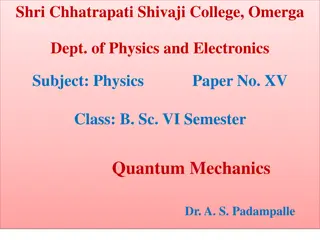Quantum Physics Course at USTC: Foundations and Applications
Provide knowledge of quantum mechanics/chemistry concepts, tools, and mathematical skills. Topics include particle-in-box, harmonic oscillator, perturbation theory, electronic structure theory, and quantum entanglement. Quantum mechanics is vital for understanding atoms, molecules, chemical bonds, and properties in various scientific fields.
Download Presentation

Please find below an Image/Link to download the presentation.
The content on the website is provided AS IS for your information and personal use only. It may not be sold, licensed, or shared on other websites without obtaining consent from the author.If you encounter any issues during the download, it is possible that the publisher has removed the file from their server.
You are allowed to download the files provided on this website for personal or commercial use, subject to the condition that they are used lawfully. All files are the property of their respective owners.
The content on the website is provided AS IS for your information and personal use only. It may not be sold, licensed, or shared on other websites without obtaining consent from the author.
E N D
Presentation Transcript
2020 Fall, USTC Course QQ: 600385410 Quantum Physics (003155.e1) Venue: 5407; Monday 09:45-11:20; Wednesday 09:45-11:20 Instructors: Prof. YAN Yijing( ) yanyj@ Prof. HU Shuiming( ) smhu@ Teaching Assistant: Mr. YING Wenxiang ( ) Mr. Lian Bin( ) ywx001@mail. ustc_mitlb@mail. 1
Textbook: Ira N. Levine, Quantum Chemistry, 7thed. (2014) References: a) (I) (2019) b) David J. Griffith, Introduction to Quantum Mechanics, 3rd ed. (2018) c) R. Shakar, Principles of Quantum Mechanics, 2nded. (1994) d) J. J. Sakurai, Modern Quantum Mechanics, (1994) e) , I/II, 4thed.
Course Description To provide a working knowledge of the concepts, basic results and mathematical skills in quantum mechanics/chemistry The principles and basic tools in quantum mechanics Particle-in-box and one-dimensional tunneling problems Harmonic oscillator Angular momentum theorem, with applications to molecular rotation, and electronic orbitals and spins Hilbert-space formulations and representations Perturbation theory and variational principle Introduction of electronic structure theory, with applications to atomic/molecular structures, spectroscopy, & chemical bonding Density matrix and Liouville-space descriptions Quantum entanglement (if possible)
Quantum Mechanics -- Foundation of all modern fields of sciences, including chemistry, biology, and material sciences. It is the ONLY way to TRULY understand Nature of atoms, chemical bonds, and molecules Structures and properties matters Intermolecular forces (hydrogen bonds and van der Waals forces) Enzymology, proteinomics, and genomics Nanoscience and material science Property of electromagnetic radiation (such as light) Matter interaction with external electromagnetic fields Quantum Chemistry is built up on the principles of quantum mechanics, and provides further the molecular understanding on the structures and properties of chemical compounds, materials, and biological processes
Coverage Topic 0: Opening Remarks and Background Skills Classical Mechanics; Mathematical Tools in QM Topic 1: Quantum Mechanics: Concepts and Principles (Ch1) Birth of QM and landmarks Topic 2: Solving Schr diner Equation for Basic Systems (Ch2&4) Particle in a box; Quantum well; Tunneling; Particle in a ring; Harmonic oscillator Topic 3: QM Machineries (Ch3-5,7) QM postulations; Hilbert-space formulations; Representation theory; Commutators vs uncertainty relations; Harmonic Oscillator via Algebraic Approach; Angular Momentum Theorem and Applications Topic 4: Rotation and Vibration Spectroscopy (Ch6) Topic 5: Electronic Structure and Spectra (Ch6) Topic 6: Variation Principle and Perturbation Theory (Ch8,9) Topic 7: Density Matrix & Liouville-space Formulations
Topic 0 A. Background Knowledge
Background Knowledge (self-revision) Classical Mechanics : Newton s Law Total energy = kinetic energy + potential energy Angular momentum of rotation in 3D space : ; i.e.,
Background Knowledge (self-revision) MATHEMATICAL TOOLS Spherical Coordinates versus Cartesian Coordinates Complex Number/Variable ODE Vector and Matrix
Background Knowledge (self-revision) MATH TOOLS : Spherical versus Cartesian Coordinates
Background Knowledge (self-revision) MATH TOOLS : Complex Numbers
Background Knowledge (self-revision) MATH TOOLS : ODE eikxand e ikxare two solutions to the above ODE (i) (ii) cos(kx) and sin(kx) are also two solutions (iii) General solution: f (x) = c1cos(kx) + c2sin(kx) (iv) Determine c1 and c2 via the initial (boundary) values, f (x = 0) and f (x = 0) / x
Background Knowledge (self-revision) MATH TOOLS : Vector and Matrix Summation i.e.,
Background Knowledge (self-revision) MATH TOOLS : Vector and Matrix Multiplication Denote C = AB, then In general, AB BA
Linear Algebra used in QM (notation and definition ) Matrix Determinant : Permutation on the column indices, k = 1, 2, , N ; pk: Number of swaps for the specified permutation; Sum runs over all N! permutations = A11A22 A12A21 a) = A11A22A33 A11A23A32+ A12A23A31 A12A21A33 b) + A13A21A32 A13A22A31
Linear Algebra used in QM Matrix Determinant : Permutation on the column indices, k = 1, 2, , N ; pk: Number of swaps for the specified permutation; Sum runs over all N! permutations (i) Exchange of two rows (or columns) causes a minus sign (ii) |AB| = |A| |B| Exercises: Use 2 2 matrixes to prove the above properties of matrix determinant :
Background Knowledge (self-revision) MATH TOOLS : Vector and Matrix Unit Matrix useful notation ! i.e., Matrix Inverse A 1: (formal definition) a) Prove: (AB) 1= B 1A 1 1 b) Evaluate
Background Knowledge (self-revision) MATH TOOLS : Vector and Matrix Matrix Transpose : change row to column; i.e., (AT)jk= Akj a) Prove that (AB)T= BTAT, in particular, Here, the row vector, , is the corresponding column vector transpose b) Dot product (also called inner product) of two real vectors: In 3D real space, Inner product is representation invariant c) Length of a real vector:
Background Knowledge (self-revision) MATH TOOLS : Vector and Matrix Inner Product (also called dot product) of two real vectors a) In 3D real space, b) Real vectors, and , are said to be orthogonal, if = 0 c) Length of a real vector: d) Inner product is representation invariant
Topic 0 (self-study mainly) Linear Algebra used in QM (Vectors and Matrixes are in Complex Space)
Linear Algebra used in QM 1. Matrix /Vector Adjoint (complex transpose = dagger ) (length square of a complex vector) 2. Vectors in Dirac bra-ket notation bra| : |ket : adjoint row vectors column vector
Linear Algebra used in QM 3. Inner Products of Two Vectors in General bra | ket Inner product results in a complex number (c-number) : (i) Vectors |u and |v are said to be Orthogonal, if u | v = 0 (ii) Length of a vector: |v| = v|v 1/2 (iii) Vector is said to be normalized, if its length |v| = 1 (iv) Inner product is representation invariant (i.e., does not depend on representation coordinate systems)
Linear Algebra used in QM 4. Outer Products of Two Vectors Results in a Matrix 5. Matrix Trace Tr A A11+ A22+ + ANN (sum of all diagonal elements) (ii) Tr (|v u|) = u|v (i) Tr (AB) = Tr (BA) (iii) Matrix trace and matrix determinant are representation invariant
Linear Algebra used in QM 6. Unitary Matrix : ; i.e., (i) Column vectors of a unitary matrix are all mutual orthogonal; each vector is normalized (ii) Real unitary matrix = ordinary orthogonal matrix e.g.
Linear Algebra used in QM 7. Hermitian Matrix (self-adjoint) : or Examples (Real symmetric matrix is a special case of Hermitian matrix) Prove : The adjoint matrix, , and Hermitian matrix, = A , can be equivalently expressed as for Hermitian A for any matrix
Linear Algebra used in QM eigenvalue eigenvector 8. Eigenequation for a Matrix : (i) For an N N matrix, there are N eigenvalues, 1, 2, , N (ii) Each eigenvalue, j, is associated with an eigenvector, (iii) Solve the eigenequations for the 2 2 matrixes in previous slide
Linear Algebra used in QM 9. Eigenequation of Hermitian matrix : where (9) Eigenvalues for a Hermitian matrix are real Proof: Applying to Eq. (9) , (10a) Taking its complex conjugate, followed by using , (10b) (10a) (10b) : Thus, the eigenvalue must be real . (QED)
Linear Algebra used in QM 9. Eigenequation of Hermitian matrix : where (9) Eigenvalues for a Hermitian matrix are real Eigenvectors associated with different eigenvalues are orthogonal Proof: Recast Eq. (9) as Hermitian A and resulting real (9 ) Applying and to Eqs. (9) and (9 ), respectively , It is to say that the eigenvectors of a Hermitian matrix, associated with different eigenvalues, are orthogonal. (QED)
Linear Algebra used in QM 9. Eigenequation of Hermitian matrix : where Eigenvalues for a Hermitian matrix are real Eigenvectors associated with different eigenvalues are orthogonal ( Proofs of both properties are required ! )
Linear Algebra used in QM 10. Hermitian Matrix diagonalized by Unitary Matrix, as Eigenvalues of matrix A normalized eigenvector, |U1 , associated with eigenvalue 1 It is equivalent to ; j = 1, , N
Linear Algebra used in QM [A, B] AB BA 11. Commutator : Verify and memorize the following identities : (i) [B, A] = [A, B] ; (ii) [ A, B] = [A, B] [A+C, B] = [A, B] + [C, B] (iii) (iv) [AC, B] = A [C, B] + [A, B] C
